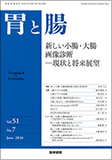Japanese
English
- 有料閲覧
- Abstract 文献概要
- 1ページ目 Look Inside
- 参考文献 Reference
- サイト内被引用 Cited by
要旨●小腸・大腸疾患における体外式超音波は壁の層構造,血流,硬さなどを評価することのできるユニークな診断法であり,多くの疾患の診断が可能であることを症例提示を中心に概説した.進行癌の典型的超音波像は層構造の消失した限局性壁肥厚である.一方,急性炎症は粘膜下層を中心とする比較的範囲の広い壁肥厚として描出される.IBDにおいては,肥厚の程度や血流の評価によりその活動性を推測することができる.絞扼性腸閉塞やNOMIの診断に造影超音波は非常に有用であり,その診断能も高い.体外式超音波は単に非侵襲的で簡便なだけでなく,その高い空間分解能やリアルタイム性,微細血流の表示など,スクリーニングから精査まで幅広く応用できる診断法である.
In this study, we have discussed the ultrasonographic diagnosis of intestinal diseases. Using ultrasonography, one can not only detect specific lesions, such as thickening of the intestinal wall, but can also evaluate wall stratification, blood perfusion, and stiffness. These characteristics are very useful for diagnosing and evaluating the degree of inflammatory bowel disease activity. Typical ultrasonographic features of advanced cancers are focal wall thickening without wall stratification, whereas in acute inflammation there is segmental wall thickening, mainly due to submucosal edema. Contrast ultrasonography is extremely useful for the diagnosis of intestinal ischemia caused by intestinal strangulation or NOMI. Considering the advantages of ultrasonography, such as non-invasiveness, easy to use, and cost effectiveness, it should be considered as a first-line modality for the diagnosis of intestinal diseases.

Copyright © 2016, Igaku-Shoin Ltd. All rights reserved.


